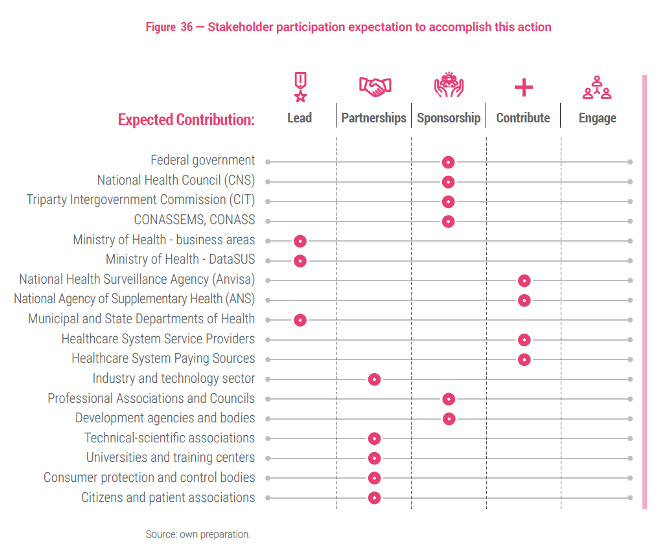In this section, we will cover:
What individuals could do with their digital health records after viewing and downloading them
How individuals could share their records with other providers and individuals
How individuals could integrate their records with other systems or apps of their choice
How industry standards could enable health records integration
In the Individual Access section, we discussed how individuals can view or download their records. Here, we will cover what individuals can do with data they download, such as integrating it with apps or sharing it with other people. Individuals may benefit if they share their data seamlessly and securely with digital health tools of their choice (also called health records integration). Sharing their own data allows individuals to mitigate concerns of whether their provider has their most updated and accurate health data, and whether individuals can share that data with third party apps and individuals as desired.
How Can Individuals Share Records with Providers?
Some GDHP members note individuals can share their data with providers using HL7® FHIR® industry standards, country-specific data standards, or human-readable portable document formats (PDFs). The Netherlands describes their programs that use standards for sharing records between individuals and providers.
The Netherlands | From Around the Globe
MedMij Organization and Standards-Based Framework for Trusted Exchange
MedMij is a foundation, an initiative of the Dutch Patients Federation, which began in 2015. Their core task is “to facilitate the digital exchange of health data between residents of the Netherlands and their care-givers. MedMij is also creating confidence that this is done in a secure, affordable, future-proof and user-friendly way. One of the ways MedMij is doing this is by designing a solid framework.” (77) The framework specifies standards based on HL7® FHIR®. The MedMij label builds trust by indicating that a product or service complies with the framework. The framework supports a “Personal Health Environment (PHE)…a digital tool in which you can keep track of information about your own health and actively work on your health. The PHE allows you to manage medical data and to also share it with others.” (78)
Data are typically more shareable if they follow industry standards as demonstrated in the MedMij example. Considerations include:
- Structure: resources, documents, or messages in standards such as HL7® FHIR®, HL7® Clinical Document Architecture (CDA®) HL7® v2, and Digital Imaging and Communications in Medicine (DICOM®);
- Semantics: data including terminology, vocabulary, and classification standards such as Systematized Nomenclature of Medicine Clinical Terms (SNOMED CT®) and the International Classification of Diseases (ICD-10); and
- Application Programming Interfaces (APIs): access systems such as those in HL7® FHIR® or Integrating the Health Enterprise (IHE) Technical Frameworks.
Industry standards can assist in data sharing from provider-to-provider, provider-to-individual, or individual-to-third-party services. Some companies develop health apps that help individuals manage their health data.
A European eHealth digital services infrastructure called My Health @ EU (79) uses international standards for cross-border health information exchange. An example of a standard that can be used across borders is the International Patient Summary (IPS) which is a minimal and non-exhaustive set of an individual’s health data that is readily usable by the receiving provider for scheduled and unscheduled care scenarios. The IPS can be used across organizations, across a country (e.g., among states or provinces), across a global region, or across country borders. (80)
Portugal is one of the countries that uses My Health @ EU standards. Portugal provides individuals many capabilities in their national portal, and they recognize individuals may want to use their data outside of the portal.
Portugal | From Around the Globe
The National Portal Offers Many Actions Beyond Viewing
For institutions integrated into Portugal’s National Health Service, the portal offers many capabilities. After viewing their health information, users can then perform many actions through the portal, such as:
- Record measurements of weight, height, blood glucose, blood pressure, cholesterol, etc.
- Upload health documents, such as clinical analyses, medical reports and similar.
- Share health data with health professionals.
- Book medical appointments for primary care providers.
- Request a prescription for chronic medication.
- Associate their household, making it possible to make medical appointments and request chronic medication prescriptions for family members.
- Consult data contained in the Clinical Summary: allergies, medication, diagnoses, surgeries, and vaccinations. (47)
Portugal also supports the My Health @ EU standards for individuals who download their data to share with other providers.
The capabilities mentioned above, particular for lab exams, are not yet available to the entire Portuguese population. Coverage depends on the participation and integration of private entities into the ongoing “Paperless Exames” project.
How Can Individuals Share and Integrate Their Records with Other Services?
The standards used for sharing information among individuals and providers are also applicable to integrating records with other services such as mobile health apps. Before discussing the standards, we observe that the range of services varies widely among GDHP members. The Kingdom of Saudi Arabia provides a representative list.
Kingdom of Saudi Arabia | From Around the Globe
Individuals Integrating Downloaded Data with Systems
The Kingdom of Saudi Arabia has many systems where individuals can integrate the records they download, such as:
- Individual portals offered by healthcare providers allow direct access to medical records and test results.
- Health apps enable data aggregation from multiple sources and tracking of health metrics.
- Personal Health Record platforms are standalone platforms for individuals to gather and manage their health information.
- Wearable health devices are used to track physical activity, sleep patterns, and other health metrics over time.
- Health Information Exchange platforms enable access to aggregated information from multiple participating providers.
- Online personal health tools exist on the web to organize and manage health information from various sources.
Some GDHP members actively seek ways to connect data to personal health devices that individuals use. For example, Brazil finds and recommends interoperable ways for individuals to connect to apps and devices to manage their health.
Brazil | From Around the Globe
Promote Connectivity and Interoperability Across Systems and Devices
Through its National Digital Health Strategy (55), Brazil aims to consolidate and expand the use of personal health record systems that are interoperable with other clinical information systems, through its national interoperability platform called the National Health Data Network (RNDS). The platform promotes the exchange of information between different points of the healthcare network, allowing continuity of care in the public and private sectors. The RNDS information is disseminated through Sistema Único de Saúde (SUS) Digital (81), a digital health solution to facilitate access to health information, which exists in versions for its users (citizens and professionals). Users of SUS Digital, individuals, their families, and communities are encouraged to understand, store, access, and search, and use their healthcare data. Brazil wants individuals to take ownership of their information, become familiar with using the information, and manage their health in their community. One of Brazil’s main digital health governance bodies is the Digital Health Steering Committee (82) which brings together representatives from municipalities and states, health secretariats and agencies, and organizations such as the Oswaldo Cruz Foundation.
There is a wide range of organizations involved for each action in the National Digital Health Strategy as shown in the sample below.

GDHP members supporting the use of interoperability standards and implementation guides have had success exchanging health data. HL7® FHIR® (83) is an example of an industry standard for healthcare that provides APIs for health apps as well as electronic health records. (84)
United States of America | From Around the Globe
Help Individuals through Standards and APIs
The ASTP/ONC Patient Engagement Playbook notes, “One way for patients to access their EHR data is through an application programming interface (API). The availability of APIs enables third-party app developers to connect patients’ EHR data to new types of applications and online tools. By enabling third-party API access to data from your EHR when patients request it, you can help empower your patients to use these innovative tools to support their health goals.” (85) ASTP recommends a set of standards to view, download and transmit data from EHRs. (86)
Practical use of the APIs in health apps is in its very early stages of adoption. The study, Individuals’ Access and Use of Patient Portals and Smartphone Health Apps, 2022, found that only two percent of individuals used an app to combine medical information from different portals or online medical records in 2022. (66)
How Are Health Apps Used?
Some apps intend to unify an individual’s data so the individual and caregivers can look through the data in their health records. Some health apps are owned by private companies and others are country-sponsored. One example of a country-sponsored example is the My Health Record app in the Republic of Korea. The app allows users to view and download their health data, such as medical history, checkup results, vaccination records, and prescription history, in HL7® FHIR® and PDF formats.
You can educate your population through apps if you learn about the types of apps used. Some countries refer their population to trusted sources. In the Netherlands, for example, MedMij is the standard for the secure exchange of health data between care users and care providers. In Brazil, efforts to promote connectivity and interoperability across systems and devices, including apps, is part of their individual engagement efforts. In Sweden, surveys are done to learn more about how the population uses health care apps.
Sweden | From Around the Globe
Who Uses Health Care Apps?
From the findings of the 2023 survey, The Swedes and the Internet, the Swedish Internet Foundation observed that the utilization rate of using eHealth services is 80% but varies considerably among population groups and by whether there was a need for a doctor’s visit at all, as well as the type of care or advice needed during the doctor’s visit. The survey concludes the COVID-19 pandemic likely impacted the utilization over time. The survey’s observations included statistics such as:
- Over 20% of Swedes have used healthcare apps for digital doctor’s appointments via video calls which is a slight decrease from 2022 (24%) to 2023 (22%).
- Those who primarily use healthcare apps are women under the age of 50. Almost 40% of these women have used a healthcare app for a digital doctor’s visit in the past year.
- Around 90% of pensioners have not used healthcare apps. This applies to younger pensioners aged 65–75 and older pensioners over the age of 75. (87)
Health Records Integration Recap
Health records integration actions include:
- Encourage the use of industry standards to make it easier for individuals to exchange data with other providers or digital health systems and apps;
- Learn more about how individuals (across demographics, such as age, gender, or education) use their data and what app functionality they find most useful;
- Learn more about how individuals want to integrate their data into apps;

